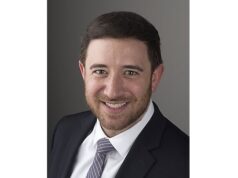 New research to be presented at the Radiological Society of North America (RSNA; 26–30 November 2023, Chicago, USA) annual meeting has found that, by using an image-guided minimally-invasive procedure, patients suffering from long COVID can have their sense of smell restored.
New research to be presented at the Radiological Society of North America (RSNA; 26–30 November 2023, Chicago, USA) annual meeting has found that, by using an image-guided minimally-invasive procedure, patients suffering from long COVID can have their sense of smell restored.
Parosmia is the name given to the condition where the sense of smell does not work correctly and has long been identified as a symptom of COVID-19, with recent research showing that up to 60% of COVID-19 patients have reported this symptom.
Lead author Adam C Zoga (Jefferson Health in Philadelphia, Pennsylvania, USA) and colleagues state that the majority of patients recover their sense of smell after a period. However, some patients with long-COVID do not, these patients reporting symptoms that last weeks, months and even years, “negatively impacting their appetite for food and overall quality of life”, the researchers note.
“Post-COVID parosmia is common and increasingly recognised,” said Zoga, in a recent press release. “Patients can develop a distaste for foods and drinks they used to enjoy”. Concurrently, the investigators state that distorted sense of smell can affect smell perception, potentially causing phantosmia—a condition that causes individuals to detect smells that are not in their environment.
To investigate possible treatments for patients with long-COVID induced parosmia, Zoga et al considered the potential benefits of computed-tomography (CT)-guided stellate ganglion block. They expand that, as part of the autonomic nervous system, which regulates involuntary processes including heart rate, blood pressure, breathing and digestion, the stellate ganglia are nerves on each side of the neck. They deliver certain signals to the head, neck, arms and a portion of the upper chest.
Using a stellate ganglion block, the researchers injected anaesthetic directly into the stellate ganglion on one side of the patients’ neck, stimulating the regional autonomic nervous system. As Zoga and colleagues state, the procedure is minimally invasive and takes under 10 minutes, requiring no sedation or intravenous analgesia.
For their study, 54 patients were referred from an ear, nose and throat specialist after at least six months of post-COVID parosmia that was resistant to pharmaceutical and topical therapies. CT guidance was then used to position a spinal needle at the base of the neck for injection into the stellate ganglion. The researchers note that they added a small dose of corticosteroid to the anaesthetic in the pharmacologic preparation, suspecting that the COVID virus may be causing nerve inflammation.
Commenting on their initial results, Zoga observes a “tremendously positive outcome, almost immediately, with continued improvement to the point of symptom resolution at four weeks”.
Follow-up was obtained from 37 patients overall, and revealed 22 patients who reported “significant progressive improvement” by one month post-procedure. Furthermore, at three months, Zoga et al state there was a mean improvement in symptoms of 49% among the 22 patients.
The investigators offered patients a second injection on the other side of the neck at least six weeks after the first. They note that 26 patients returned for this procedure, but found that a second injection was not effective in patients who did not respond to the first. Of patients who did see improvement after the first, 86% reported additional improvements after the second injection.
“We have been surprised at some outcomes, including near 100% resolution of phantosmia in some patients throughout the trial,” Zoga comments, adding that “other treatments have failed to date” however “this injection is working”.
The researchers share these results ahead of their presentation at the RSNA 2023 meeting and state that data will continue to be updated right up until the session takes place.











